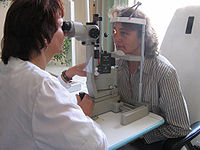
Photo from wikipedia
Recent advances in technology such as optical coherence tomography, wideview imaging and the iCare tonometer have made more accurate diagnosis in children possible [1]. However, there are times where an… Click to show full abstract
Recent advances in technology such as optical coherence tomography, wideview imaging and the iCare tonometer have made more accurate diagnosis in children possible [1]. However, there are times where an examination under anaesthesia (EUA) is still necessary. These children often have behavioural issues due to underlying comorbidities requiring multiple specialist input at dedicated paediatric hospitals. To reduce the risks of repeated general anaesthetic [2] ophthalmologists carry out their examinations while a child is anaesthetised for another reason; i.e. neuroimaging. This is unique and an under-recognised aspect of paediatric ophthalmology. We present data of ophthalmic examinations taking place in children undergoing a general anaesthetic for non-ophthalmic issues. A retrospective case note review of all children undergoing an ophthalmic EUA in a single paediatric hospital in the United Kingdom (UK) on any non-ophthalmic list between January 2017 to July 2019 inclusive was performed. Information collected included age, underlying diagnosis, location, grade of ophthalmologist and procedures undertaken. No children were excluded. Sixty-five children underwent an EUA on a nonophthalmic list. Mean age was 5.4 years old (SD ± 5.08 years) (range 14 weeks–23 years old). The most common diagnosis was tuberous sclerosis (21.5%, n= 13). The full list of diagnoses can be found in Table 1. Fundal examination was carried out in 53 children (81.5%) and anterior segment examination in 43 of them (66%). Cycloplegic retinoscopy was required in 23 children (35.3%) and 12 (18.5%) had an IOP measurement. During 7 (11%) of the EUAs, an ophthalmology procedure was carried out in the same sitting and this included 4 syringe and probing, 1 meibomian gland expression, 1 botulinum toxin for a squint and 1 cleaning an artificial eye. Forty-two children (64.6%) had an examination during a magnetic resonance imaging (MRI) scan. Twenty-three (35%) examinations took place in theatre. The reasons for general anaesthetic were varied and ranged across 14 different specialities. Twenty-seven (42%), 22 (34.4%) and 14 (20.3%) examinations were performed by fellows, trainees and consultants, respectively. This is the first article reporting ophthalmic EUAs on non-ophthalmic lists. Approximately four EUAs take place every 5 weeks in a tertiary paediatric hospital.
Journal Title: Eye
Year Published: 2021
Link to full text (if available)
Share on Social Media: Sign Up to like & get
recommendations!